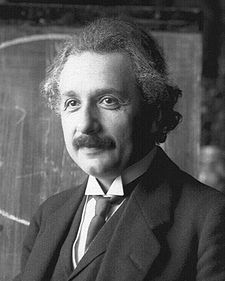
Tea leaf paradox
Encyclopedia

Phenomenon
A phenomenon , plural phenomena, is any observable occurrence. Phenomena are often, but not always, understood as 'appearances' or 'experiences'...
where tea leaves in a cup
Teacup
A teacup is a small cup, with or without a handle, generally a small one that may be grasped with the thumb and one or two fingers. It is typically made of a ceramic material. It is usually part of a set, composed of a cup and a matching saucer. These in turn may be part of a tea set in...
of tea
Tea
Tea is an aromatic beverage prepared by adding cured leaves of the Camellia sinensis plant to hot water. The term also refers to the plant itself. After water, tea is the most widely consumed beverage in the world...
migrate to the center and bottom of the cup after being stirred rather than being forced to the edges of the cup, as would be expected from a spiral centrifugal force
Centrifugal force
Centrifugal force can generally be any force directed outward relative to some origin. More particularly, in classical mechanics, the centrifugal force is an outward force which arises when describing the motion of objects in a rotating reference frame...
. The solution first came from Albert Einstein
Albert Einstein
Albert Einstein was a German-born theoretical physicist who developed the theory of general relativity, effecting a revolution in physics. For this achievement, Einstein is often regarded as the father of modern physics and one of the most prolific intellects in human history...
in a 1926 paper where he used it to explain the erosion of river banks (Baer's law
Baer's law
In geology, Baer's law, named after Karl Ernst von Baer, says that, because of the rotation of the earth, in the Northern Hemisphere, erosion occurs mostly on the right banks of rivers and in the Southern Hemisphere on the left banks...
).
Explanation
Stirring the liquid makes it spin around the cup. In order to maintain this curved path, a centripetal force in towards the center is needed (similar to the tension in a string when spinning a bucket over your head). This is accomplished by a pressure gradient outward (higher pressure outside than inside).However, near the bottom and outer edges the liquid is slowed by the friction
Friction
Friction is the force resisting the relative motion of solid surfaces, fluid layers, and/or material elements sliding against each other. There are several types of friction:...
against the cup. There the centrifugal force is weaker and cannot overcome the pressure gradient, so these pressure differences become more important for the water flow. This is called a boundary layer
Boundary layer
In physics and fluid mechanics, a boundary layer is that layer of fluid in the immediate vicinity of a bounding surface where effects of viscosity of the fluid are considered in detail. In the Earth's atmosphere, the planetary boundary layer is the air layer near the ground affected by diurnal...
or more specifically an Ekman layer.
Because of the centrifugal force, the pressure is higher along the rim than in the middle. If all the liquid rotated as a solid body, the inward (centripetal
Centripetal force
Centripetal force is a force that makes a body follow a curved path: it is always directed orthogonal to the velocity of the body, toward the instantaneous center of curvature of the path. The mathematical description was derived in 1659 by Dutch physicist Christiaan Huygens...
) force would match the outward (centrifugal) force from the rotation and there would be no inward or outward movement.
In a teacup, where the rotation is slower at the bottom, the pressure gradient takes over and creates an inward flow along the bottom. Higher up, the liquid flows outward instead. This secondary flow
Secondary flow
In fluid dynamics, a secondary flow is a relatively minor flow superimposed on the primary flow, where the primary flow usually matches very closely the flow pattern predicted using simple analytical techniques and assuming the fluid is inviscid...
travels inward along the bottom bringing the leaves to the center, then up, out and down near the rim. The leaves are too heavy to lift upwards, so they stay in the middle. Combined with the primary rotational flow, the leaves will spiral inward along the bottom.
Applications
The phenomenon has been used to develop a new technique to separate red blood cellRed blood cell
Red blood cells are the most common type of blood cell and the vertebrate organism's principal means of delivering oxygen to the body tissues via the blood flow through the circulatory system...
s from blood plasma
Blood plasma
Blood plasma is the straw-colored liquid component of blood in which the blood cells in whole blood are normally suspended. It makes up about 55% of the total blood volume. It is the intravascular fluid part of extracellular fluid...
to understand atmospheric pressure systems, and in the process of brewing
Brewing
Brewing is the production of beer through steeping a starch source in water and then fermenting with yeast. Brewing has taken place since around the 6th millennium BCE, and archeological evidence suggests that this technique was used in ancient Egypt...
beer
Beer
Beer is the world's most widely consumed andprobably oldest alcoholic beverage; it is the third most popular drink overall, after water and tea. It is produced by the brewing and fermentation of sugars, mainly derived from malted cereal grains, most commonly malted barley and malted wheat...
to separate out coagulated trub
Trub (brewing)
In the process of brewing beer, trub refers to the layer of sediment that appears at the bottom of the fermenter after yeast has completed the bulk of the fermentation...
in the whirlpool.

